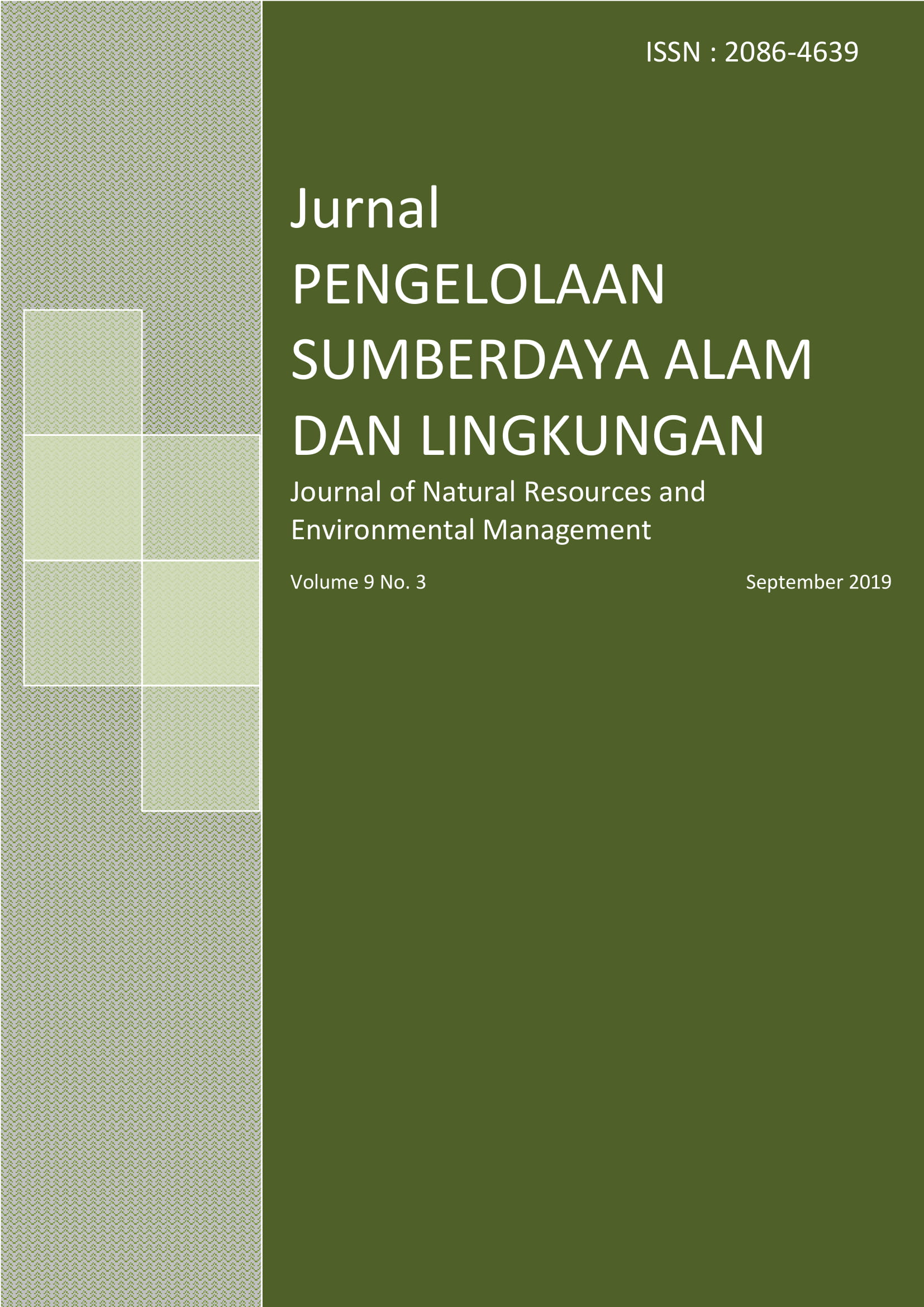Analisis Faktor-Faktor Teknologi dan Sosial Budaya yang Mengancam Keberlanjutan Kemandirian Pangan Pokok di Provinsi Jawa Barat, Indonesia
Abstract
References
[BPS] Badan Pusat Statistik Provinsi Jawa Barat. 2008. Provinsi Jawa Barat Dalam Angka Tahun 2007. Bandung: BPS Provinsi Jawa Barat.
[BPS] Badan Pusat Statistik Provinsi Jawa Barat. 2016. Provinsi Jawa Barat Dalam Angka Tahun 2015. Bandung: BPS Provinsi Jawa Barat.
[DSDA] Dinas Sumber Daya Air Provinsi Jawa Barat. 2017. Buku Sumberdaya Air Provinsi Jawa Barat. Bandung: Balai Pusat Data dan Informasi Sumberdaya Air.
Amid J. 2007. The dilemma of cheap food and self-sufficiency: the case of wheat in Iran. Food Policy. 32: 537-552.
Azadi H, Ho P, Hasfiati L. 2011. Agricultural land conversion drivers: A comparison between less developed, developing and developed countries. Land Degradation Development. 22: 596-604.
Baraldi F, Catellini A, Ghelfi R, Palmier A, Pirazzoli C, Rivaroli S. 2006. The labour factor in agriculture: comparison, analysis and action introduced the primary sector. Conference Paper. Center for International Food and Agricultural Policy. Paper presented at the 10th Joint Conference on Food, Agriculture and the Environment, Duluth, Minnessota, August 27 – 30, 2006. [16 Maret 2018].
Borg I, Groenen PJF. 1997. Modern Multidimensional Scalling: Theory and Aplications. New York: Springer.
Dzikrillah GF, Anwar S, Sutjahjo SH. 2017. Analisis keberlanjutan usaha tani padi sawah di Kecamatan Soreang Kabupaten Bandung. Jurnal Pengelolaan Sumberdaya Alam dan Lingkungan. 7(2): 107-113.
Fauzi AS, Anna. 2002. Evaluasi status keberlanjutan pembangunan perikanan: aplikasi pendekatan rapfish (Studi kasus perairan pesisir DKI Jakarta). Jurnal Pesisir Dan Lautan. 4(3): 43-55.
Felloni F, Gilbert J, Wahl TI, Wadschneider P. 2003. Trade policy, biotechnology and Grain self-sufficiency in China. Agricultural Economics. 28: 173-186.
Firman T. 1997. Land conversion and urban development in Northern Region of West Java, Indonesia. Urban Study. 34(7):1027-1046.
Firman T. 2000. Rural to urban land conversion in Indonesia during boom and bust periods. Land Use Policy. 17: 13–20.
Firman T. 2003. The spatial pattern of population growth in Java, 1990 – 2000, Contunuity and change in extended metropolitan region formation. IDPR. 25(1): 53-65.
Firman T, Kombaitan B, Pradono P. 2007. The Dynamics of Indonesian Urbanization, 1980 – 2006. Urban Policy and Research. 25(4): 433-454.
Groenen PJF, van de Velden M. 2004. Multidimensional Scalling. No. EI 2004-15. www.repub.eur.nl/pub/1274/ei200415.pdf [18 Mei 2017].
Groenen PJF, Terada Y. 2015. Multidimensional Scalling (No. EI 2015-15). www.repub.eur.nl./pub/78189/EI2015-15.pdf [18 Mei 2017]
Handaka, Prabowo A. 2013. Kebijakan antisipatif Pengembangan Mekanisasi Pertanian. Analisis Kebijakan Pertanian. 11(1): 27-44.
Hendrawati E, Yunsnthe E, Radian. 2014. Analisis persepsi petani dalam penggunaan benih padi unggul di Kecamatan Muara Pawan Kabupaten Ketapang. Jurnal Social Economic of Agriculture. 3(1): 53-57.
Kavanagh P. 2001. Rapid Appraisal of Fisheries (Rapfish) Project. Rapid Software Description (for Microsoft Excell). Canada: University of British Columbia.
Kavanagh P, Pitcher TJ. 2004. Implementing Microsoft Excel Software for Rapfish: A Technique for The Rapid Appraisal of Fisheries Status. Canada: Fisheries Centre, University of British Columbia.
Lee MD. 2011. Determining the dimensionality of multidimensional scalling model for cognitive modelling. J. Math. Psichology. 45: 149-161.
Marimin 2004. Teknik Pengambilan Keputusan Kriteria Jamak. Bogor: IPB Press.
Mears LA. 1984. Rice and food self-sufficiency in Indonesia. Bulletin of Indonesian Economic Studies. 20(2): 122-138.
Nazam M, Sabiham S, Pramudya B, Widiatmaka, Rusastra IW. 2011. Penetapan luas lahan optimum usahatani padi sawah mendukung kemandirian pangan berkelanjutan di Nusa Tenggara Barat. Jurnal Agro Ekonomi. 29(2): 113-145.
Nurmalina R. 2008. Analisis indeks dan status keberlanjutan sistem ketersediaan beras di beberapa wilayah Indonesia. Jurnal Agro Ekonomi. 26(1): 47-79.
Pandya-Lorch R, Rosegrant MW. 2000. Prospect for food demand and supply in Central Asia. Food Policy. 25: 637–646.
Panuju DR, Mizuno K, Trisasongko BH. 2013. The dynamics of rice production in Indonesia 1961-2009. Journal of The Saudi Society of Agricultural Sciences. 12: 27-37.
Petrick M, Zier P. 2012. Common agricultural policy effect on dynamics labor use in agriculture. Food Policy. 37: 671–678.
Pitcher TJ, Preikshot D. 2001. RAPFISH: a rapid appraisal technique to evaluate the sustainability status of fisheries. Fisheries Research. 49: 255-270.
Rachmat R. 2012. Model penggilingan padi terpadu untuk meningkatkan nilai tambah. Buletin Teknologi Pascapanen Pertanian. 8(2): 99–111.
Salikin KA. 2003. Sistem Pertanian Berkelanjutan. Yogyakarta: Kanisius.
Santoso, P. B. K., Widiatmaka, Sabihan S, Machfud, Rusastra IW. 2017. Analisis pola konversi lahan sawah dan struktur hubungan penyebab dan pencegahannya (Studi kasus Kabupaten Subang, Provinsi Jawa Barat). Jurnal Pengelolaan Sumberdaya Alam dan Lingkungan. 7(2): 184-194.
Siata S. 2016. Faktor-faktor yang mempengaruhi petani dalam penerapan benih padi varietas Ciherang di Desa Pudak Kecamatan Kumpuk Ulu. Sosio humaniora. 18(3): 240-247.
Simatupang P, Timmer CP. 2008. Indonesian rice production: policies and realities. Bulletin of Indonesian Economic Studies. 44(1): 65-80.
Simelton E. 2011. Food self-sufficiency and natural hazard in China. Food Security Journal. 3: 35–52.
Authors
Authors who publish with this journal agree to the following terms:
- Authors retain copyright and grant the journal right of first publication with the work simultaneously licensed under a Creative Commons Attribution License that allows others to share the work with an acknowledgement of the work's authorship and initial publication in this journal.
- Authors are able to enter into separate, additional contractual arrangements for the non-exclusive distribution of the journal's published version of the work (e.g., post it to an institutional repository or publish it in a book), with an acknowledgement of its initial publication in this journal.
- Authors are permitted and encouraged to post their work online (e.g., in institutional repositories or on their website) prior to and during the submission process, as it can lead to productive exchanges, as well as earlier and greater citation of published work (See The Effect of Open Access).






